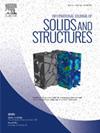A nonlinear fractional viscoelastic constitutive model for time-dependent ratchetting of polyetherimide
IF 3.4
3区 工程技术
Q1 MECHANICS
International Journal of Solids and Structures
Pub Date : 2025-06-28
DOI:10.1016/j.ijsolstr.2025.113546
引用次数: 0
Abstract
The ratchetting of polyetherimide (PEI) exhibits significant time-dependence and loading history-dependence. Fractional derivative can better reflect the overall relaxation characteristics of polymeric molecular chains, which is an effective tool for constructing the constitutive models of polymers. Therefore, in this paper, a nonlinear fractional viscoelastic constitutive model was proposed to describe the ratchetting of the PEI. Firstly, stress-dependent nonlinear functions were introduced into the fractional Poynting-Thomson model (Long et al., 2018), and evolution equations for the fractional order and viscoelastic modulus related to the hydrostatic stress in the loading history were constructed. Then, by discretizing the proposed constitutive model, a numerical calculation method for the implementation of the constitutive model was derived, effectively avoiding the direct calculation of Gamma function and Mittag-Leffler function in the definition of fractional derivative. In addition, a method to determine the material parameters of the model was proposed. Finally, by comparing the simulated results with the experimental data in the literature (Pan et al., 2012), the proposed fractional constitutive model was validated. The results show that the nonlinear fractional viscoelastic constitutive model proposed in this paper can reasonably predict the time-dependent ratchetting of the PEI under different stress levels, stress rates, and peak stress holding times using only 9 physically meaningful parameters, rather than 35 parameters used in the integer-order constitutive model developed in the literature.
聚醚酰亚胺棘轮非线性分数黏弹性本构模型
聚醚酰亚胺(PEI)的棘轮结构表现出明显的时间依赖性和加载历史依赖性。分数阶导数能较好地反映聚合物分子链的整体弛豫特性,是构建聚合物本构模型的有效工具。因此,本文提出了一种非线性分数黏弹性本构模型来描述PEI的棘轮。首先,将应力相关非线性函数引入分数阶Poynting-Thomson模型(Long et al., 2018),构建加载历史中与静水应力相关的分数阶和粘弹性模量演化方程。然后,通过对所提出的本构模型进行离散化,推导了实现本构模型的数值计算方法,有效地避免了在定义分数阶导数时直接计算Gamma函数和Mittag-Leffler函数。此外,提出了一种确定模型材料参数的方法。最后,将模拟结果与文献中的实验数据(Pan et al., 2012)进行对比,验证分数阶本构模型的有效性。结果表明,本文提出的非线性分数阶粘弹性本构模型仅使用9个有物理意义的参数就可以合理地预测PEI在不同应力水平、应力速率和峰值应力保持时间下的随时间棘轮,而不是文献中开发的整阶本构模型所使用的35个参数。
本文章由计算机程序翻译,如有差异,请以英文原文为准。
求助全文
约1分钟内获得全文
求助全文
来源期刊
CiteScore
6.70
自引率
8.30%
发文量
405
审稿时长
70 days
期刊介绍:
The International Journal of Solids and Structures has as its objective the publication and dissemination of original research in Mechanics of Solids and Structures as a field of Applied Science and Engineering. It fosters thus the exchange of ideas among workers in different parts of the world and also among workers who emphasize different aspects of the foundations and applications of the field.
Standing as it does at the cross-roads of Materials Science, Life Sciences, Mathematics, Physics and Engineering Design, the Mechanics of Solids and Structures is experiencing considerable growth as a result of recent technological advances. The Journal, by providing an international medium of communication, is encouraging this growth and is encompassing all aspects of the field from the more classical problems of structural analysis to mechanics of solids continually interacting with other media and including fracture, flow, wave propagation, heat transfer, thermal effects in solids, optimum design methods, model analysis, structural topology and numerical techniques. Interest extends to both inorganic and organic solids and structures.

 求助内容:
求助内容: 应助结果提醒方式:
应助结果提醒方式:


